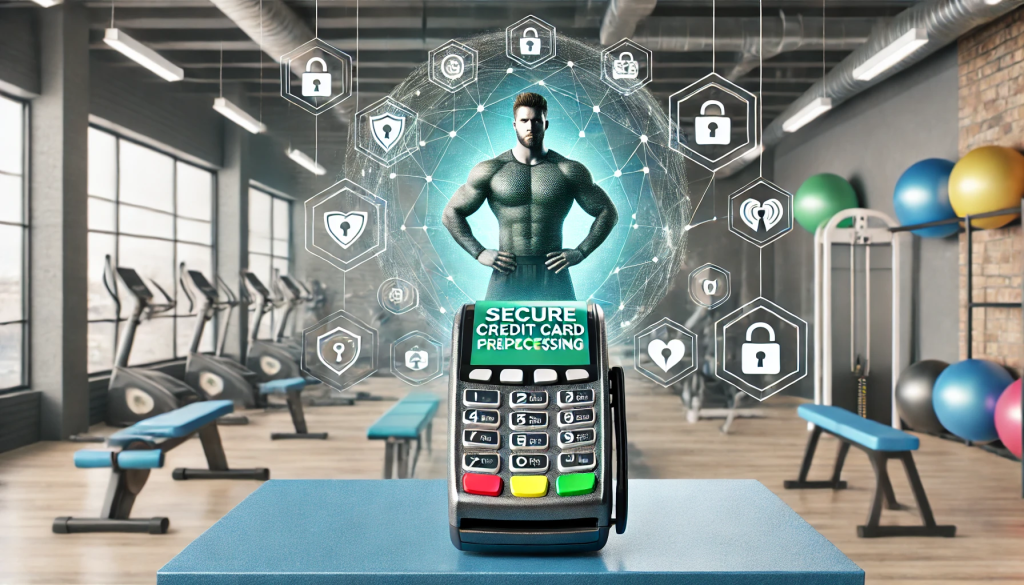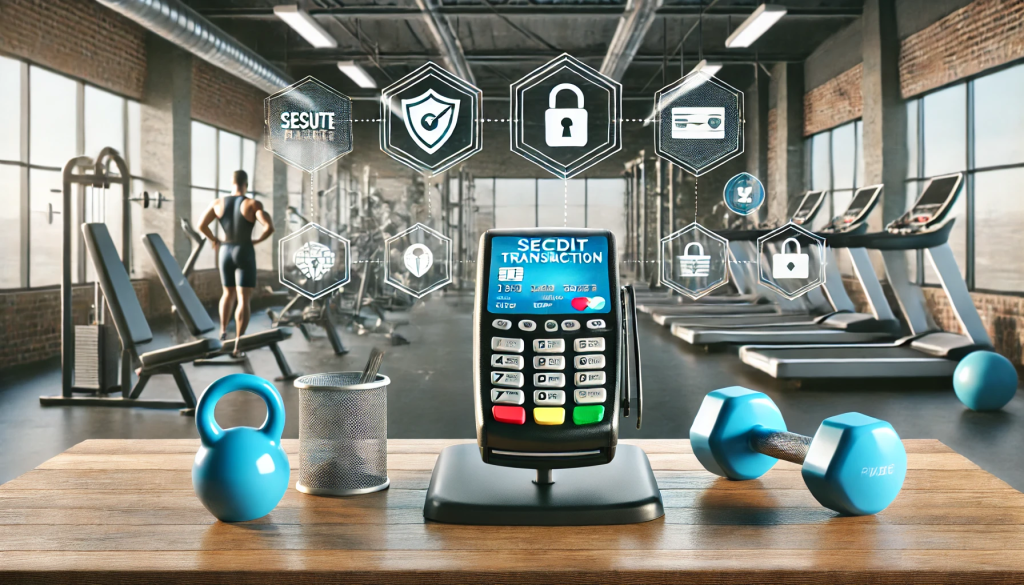
By dev October 28, 2024
In today’s fitness industry, secure credit card processing is essential for gyms and fitness centers that want to maintain a trustworthy reputation and ensure financial stability. From managing memberships to handling payments for classes and personal training sessions, a secure payment system is a must to protect customer data and streamline operations.
This article will provide you with a step-by-step guide to setting up secure credit card processing for your gym, discussing the importance of data protection, best practices for ensuring security, and the key features to look for in a payment processing system.
Why Secure Credit Card Processing Matters for Gyms

Understanding why secure credit card processing is vital will help you prioritize data protection in your gym operations. Here are some key reasons:
1. Protecting Customer Information
Gyms collect sensitive financial data from their members, including credit card information and billing addresses. Ensuring this data is protected is crucial to prevent identity theft, fraud, and data breaches.
2. Enhancing Customer Trust and Retention
Customers expect their payment information to be secure. A robust payment processing system that prioritizes security helps build trust, leading to better customer retention and positive word-of-mouth referrals.
3. Avoiding Financial and Legal Consequences
Data breaches can lead to severe financial consequences, including fines, penalties, and compensation to affected customers. Compliance with data protection regulations like the Payment Card Industry Data Security Standard (PCI DSS) can help gyms avoid legal issues.
Step-by-Step Guide to Setting Up Secure Credit Card Processing for Your Gym
To ensure your gym has a secure credit card processing system in place, follow these detailed steps:
1. Choose a Reliable Payment Processor
The first step in setting up secure credit card processing is selecting a reputable payment processor. Here’s what to look for:
A. PCI DSS Compliance
Ensure that the payment processor is PCI DSS compliant. This set of security standards is designed to protect credit card data and is mandatory for businesses handling card payments. Working with a compliant processor ensures your gym meets industry security standards.
B. Security Features
Choose a payment processor that offers advanced security features like encryption, tokenization, fraud detection, and two-factor authentication (2FA). These features help protect payment data from potential threats.
C. Integration with Gym Management Software
Look for a payment processor that seamlessly integrates with your gym management software. This integration allows for automated billing, membership management, and easy access to payment data.
2. Set Up a Secure Payment Gateway

A payment gateway is the intermediary that facilitates online transactions between your gym and your customer’s bank. It encrypts payment data, ensuring safe transmission. Here’s what to consider:
A. Look for Advanced Encryption
Ensure that the payment gateway uses advanced encryption standards like Transport Layer Security (TLS) to protect payment data during transmission. This makes it difficult for hackers to intercept sensitive information.
B. Choose a Gateway with Tokenization
Tokenization replaces sensitive payment data with unique identifiers (tokens) that are meaningless to hackers. Opt for a payment gateway that offers tokenization for additional security.
C. Evaluate Integration Capabilities
Choose a payment gateway that integrates with your existing software and website. This integration simplifies payment processing and ensures a smooth customer experience.
3. Implement Secure In-Person Payment Terminals

For gyms that accept in-person payments at the front desk, implementing secure payment terminals is essential. Here’s what to keep in mind:
A. Use EMV Chip Readers
Choose payment terminals that support EMV chip cards. EMV chip technology provides an additional layer of security compared to traditional magnetic stripe cards, reducing the risk of fraud.
B. Contactless Payment Options
Support contactless payments like NFC (Near Field Communication) through Apple Pay, Google Pay, and other mobile wallets. Contactless payments are secure and offer convenience for members.
C. Ensure PCI Compliance
Ensure that your in-person payment terminals are PCI compliant. This means they meet security standards for processing, storing, and transmitting cardholder data.
4. Integrate with a Membership Management System
Integrating your payment processing system with a membership management software can enhance security and efficiency. Here’s how:
A. Automate Billing and Recurring Payments
Membership management systems can automate billing for monthly or annual memberships, reducing the chances of manual errors and missed payments. Automated billing also provides a consistent revenue stream.
B. Monitor Payment Data in Real-Time
Integration allows you to monitor payment transactions in real time, providing insight into revenue, decline rates, and payment trends. This information helps in making informed financial decisions.
C. Provide a Seamless Customer Experience
Integration ensures that customer data is synchronized across platforms, allowing members to view and update payment information easily. This creates a seamless and professional customer experience.
Best Practices for Securing Credit Card Processing in Gyms

To maintain a secure payment environment, follow these best practices:
1. Educate Staff on Payment Security
Your staff plays a crucial role in maintaining payment security. Proper training ensures they handle payment information responsibly:
A. Train Staff on Recognizing Fraud
Train your staff to identify suspicious behavior or red flags that may indicate payment fraud. Provide them with guidelines on how to handle payment-related inquiries securely.
B. Implement Strong Access Controls
Limit access to payment data to authorized personnel only. Use role-based access controls and require staff to use strong passwords and multi-factor authentication (MFA) for access.
2. Regularly Update Payment Systems
Outdated systems are vulnerable to cyberattacks. Regularly updating your payment processing software is essential for security:
A. Schedule Routine Software Updates
Keep your payment processing software, membership management system, and payment terminals up to date. Software updates often include security patches to address vulnerabilities.
B. Conduct Regular Security Audits
Perform regular security audits to identify potential weaknesses in your payment processing setup. Consider hiring third-party experts to conduct penetration testing for a thorough assessment.
3. Use Fraud Detection Tools
Fraud detection tools can help you monitor transactions for suspicious activities and prevent fraudulent payments:
A. Set Up Alerts for Unusual Transactions
Configure your payment processor to send alerts for unusual or high-risk transactions. These alerts allow you to take immediate action to investigate potential fraud.
B. Use 3D Secure Authentication
3D Secure (3DS) is an additional security layer for online transactions. It requires customers to enter a one-time password (OTP) sent to their phone before completing the payment, reducing the risk of unauthorized transactions.
4. Ensure PCI Compliance
Compliance with PCI DSS standards is critical for protecting cardholder data. Here are some steps to ensure compliance:
A. Understand the PCI Requirements
Familiarize yourself with the 12 PCI DSS requirements, including maintaining a secure network, protecting cardholder data, and monitoring access to sensitive information.
B. Work with a PCI-Compliant Processor
Choose a payment processor that meets PCI DSS standards, reducing the burden of compliance on your gym. Ensure that you adhere to all PCI requirements, including regular vulnerability scans and security testing.
5. Provide a Secure Online Payment Experience
If your gym offers online payment options for memberships, merchandise, or class bookings, it’s essential to secure your website:
A. Use SSL Certificates
Secure Socket Layer (SSL) certificates encrypt data transmitted between your website and the customer’s browser. Ensure your website has a valid SSL certificate to protect payment data.
B. Optimize Payment Forms for Security
Simplify payment forms to reduce the risk of errors. Include only the necessary fields and ensure they are optimized for mobile devices, providing a secure and user-friendly experience.
FAQs About Setting Up Secure Credit Card Processing for Gyms
Q1: What is PCI DSS compliance, and why is it important for gyms?
PCI DSS compliance refers to adhering to security standards designed to protect cardholder data. It is essential for gyms to avoid data breaches, protect customer information, and avoid financial penalties.
Q2: What are the best payment methods to offer in a gym?
Gyms should offer a variety of secure payment methods, including credit/debit cards with EMV chip support, mobile wallets (Apple Pay, Google Pay), and contactless payments to accommodate member preferences.
Q3: How can I secure online payments for my gym’s website?
To secure online payments, use SSL certificates, integrate a secure payment gateway, simplify payment forms, and implement 3D Secure authentication for added protection against fraud.
Q4: What is the role of tokenization in payment security?
Tokenization replaces sensitive payment data with unique tokens that cannot be used by hackers. It minimizes the risk of data breaches by ensuring that actual payment information is not stored on your system.
Q5: How often should I update my payment processing software?
You should update your payment processing software regularly—whenever security patches or new features are released. This ensures that your system is protected against the latest threats.
Conclusion
Setting up secure credit card processing for your gym is not just a technical requirement—it’s a commitment to safeguarding customer information and maintaining a reliable business. By choosing a PCI-compliant payment processor, implementing secure payment gateways, and educating your staff on payment security, you can create a safe environment for transactions in your gym. Regular updates, fraud detection tools, and a focus on customer data protection will help you maintain a trustworthy reputation.
In a competitive fitness industry, secure credit card processing can set your gym apart as a professional and customer-oriented business. Customers are more likely to remain loyal to a gym that prioritizes their security, leading to increased retention and long-term success. Investing in secure credit card processing is an investment in your gym’s future, reputation, and financial stability.
By following the guidelines outlined in this article, you can confidently manage secure credit card payments, avoid common pitfalls, and provide a seamless payment experience for your members. Prioritize security, compliance, and customer trust to create a robust payment infrastructure for your gym, ensuring both safety and success in the long run.